Faster, higher, stronger
If you had a look at the Tokyo Olympics back in July this year, you would have noticed a few sports making their debut at the Games. Four new events were added to the list in Tokyo: surfing, skateboarding, sport climbing and karate. The addition of new sports is always controversial, with the crackers and French Onion dip flying as the revolutionaries and reactionaries passionately argue their positions.
Back in the good old days of the Olympics, when athletes competed starkers*, no-one considered introducing surfing, skateboarding or karate, probably because the Mediterranean has no surf, and neither skateboards nor karate had been invented. Mountain climbing wasn’t a sport, it was just something you did to get your goats back. The original Olympic Games, which apparently were conducted in 776BC, comprised a single running race. It would be more correct, therefore, to refer to this first athletic meeting as the Olympic Game. However, despite its humble beginnings, the Game broadened over the years to also include competitors jumping a long way, throwing the discus, hurting their opponent in various combat sports, and racing horses. But back before even the original Olympic athletes disrobed for their sports carnival, ancient people on the island of Crete were already hosting their own games.
The Minoans were an ancient people whose civilization centered on Crete, peaking from about 3000BC to 1100BC. They built cities and palaces, many of which you can still visit today (although they’re not looking quite so flash these days due to the ravages of time, and also from being destroyed periodically by other civilisations who were presumably jealous of the Minoans’ standard of living). This Bronze Age society had a rich cultural life, which included sporting spectacles enjoyed by all.
Although Minoans liked running races, combat sports, forms of gymnastics and powering their chariots around ancient speedways, they clearly believed there wasn’t enough, well, danger involved in these pursuits. They wanted something more spectacular than nude blokes running fast or doing somersaults, more dangerous than two nude blokes punching each other in the face, and more death-defying than (possibly nude) blokes punting their chariots around faster than forty bastards**. Something which would truly test the courage and athleticism of participants and their willingness to be mortally wounded for the glory of sport. So they invented bull leaping.
As its name suggests, bull leaping involved an athlete leaping tip-over-apex over the horns of a charging bull. If you have ever had a bull, or even a horned cow, for that matter, charge at you, you will understand the gravity of this sport. Sure the Minoans would enjoy the warm up athletic events, perhaps enjoying a chat, a few snacks and a wine in the Cretan sunshine, but it was bull leaping they had all come to see.
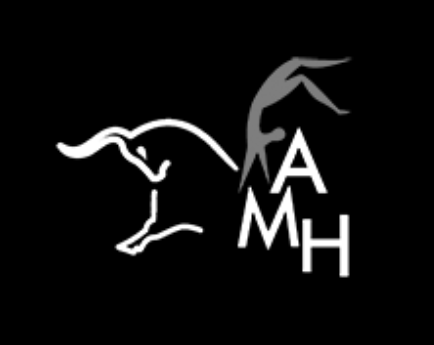
Bull leaping was held in such esteem within the Minoan culture that much evidence of the sport was left in the cultural record. There are heaps of artefacts depicting bull leaping within the Archaeological Museum of Heraklion, which, as it happens, features bull leaping in its logo.
This mosaic is perhaps one of the most significant representations of bull leaping. It was lifted from Palace of Knossos, upon which Heraklion’s southern outskirts now encroach.
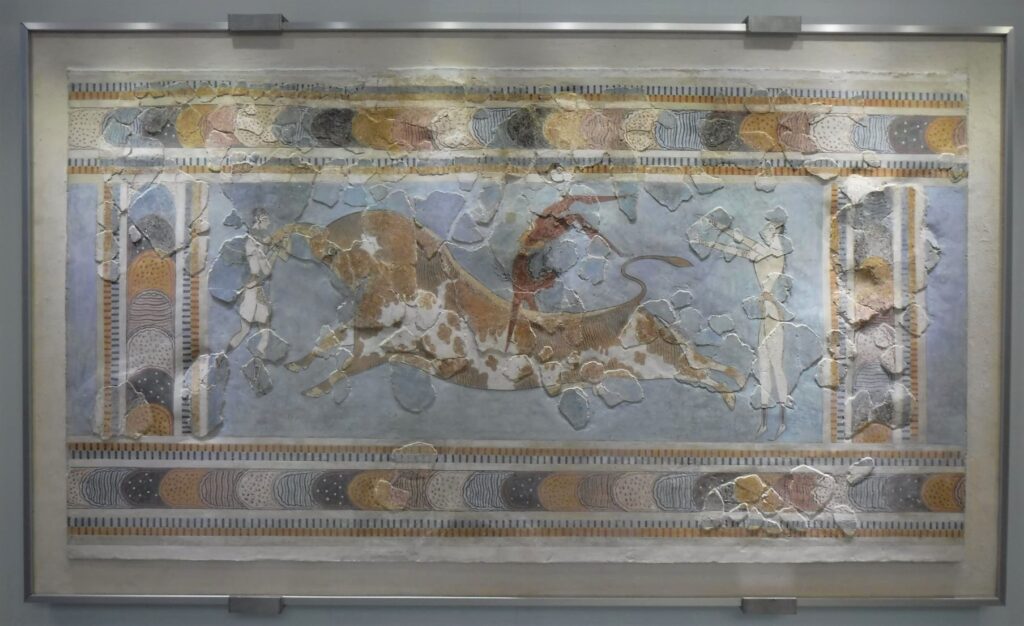
Ok so it’s a bit of a jigsaw puzzle, but you can make out a figure half way down the back of the bull performing a somersault. Now that’s gutsy. On a sunny Cretan day I walked to the Palace of Knossos for a look around, and to check out what was likely to have been a premier bull leaping venue.

But let’s get back to the Museum.
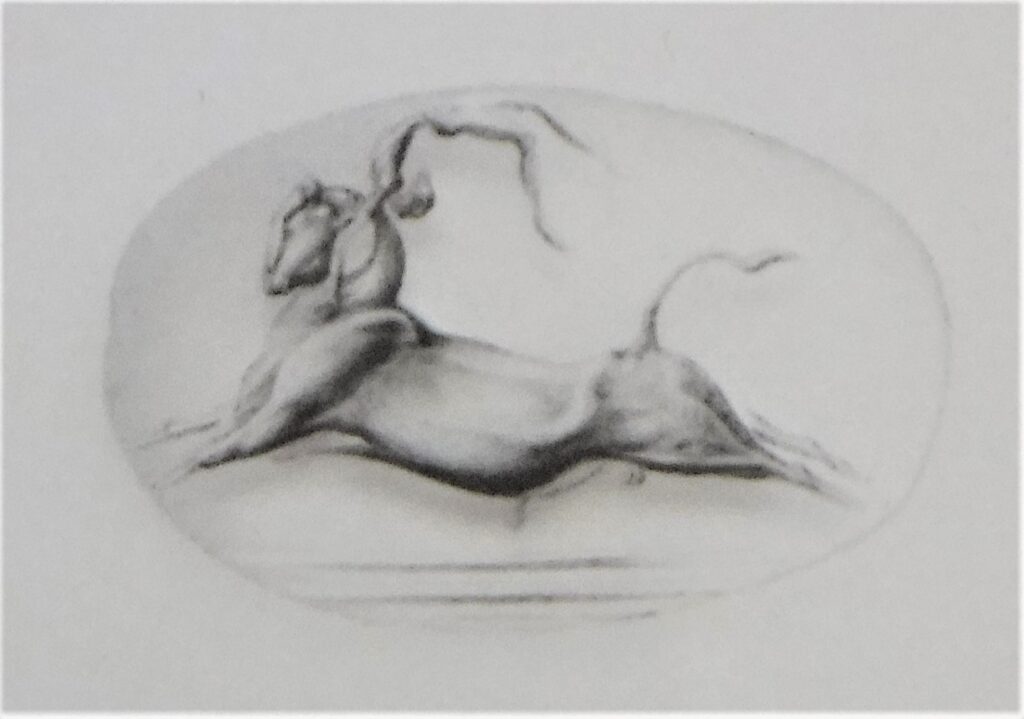
Here’s the image found on an ancient seal which turned up at the Minoan township of Gournia in eastern Crete. It shows a lithe figure going A over T over the back of a massive bull.
This is Gournia township today. Not being a grand city with a temple like Knossos, Gournia may never have hosted a bull leaping spectacular. But that doesn’t mean the residents didn’t dig the sport.

Anyway back to the museum.
In this depiction, the leaper looks like he’s using the bull’s horns in the same way as a modern gymnast uses the parallel bars. Meanwhile, his two mates have taken on the role of rodeo clowns, distracting the bull from the fact that there is a human being somersaulting over his horns. Or maybe they’re just making a bolt for it. Not sure.
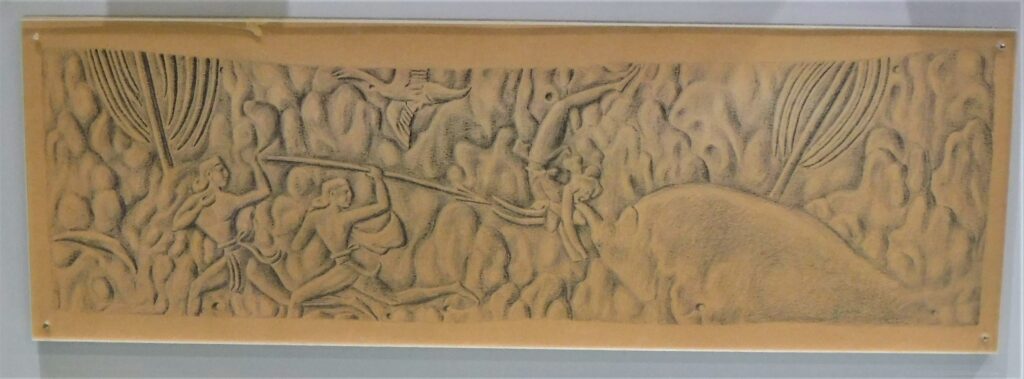
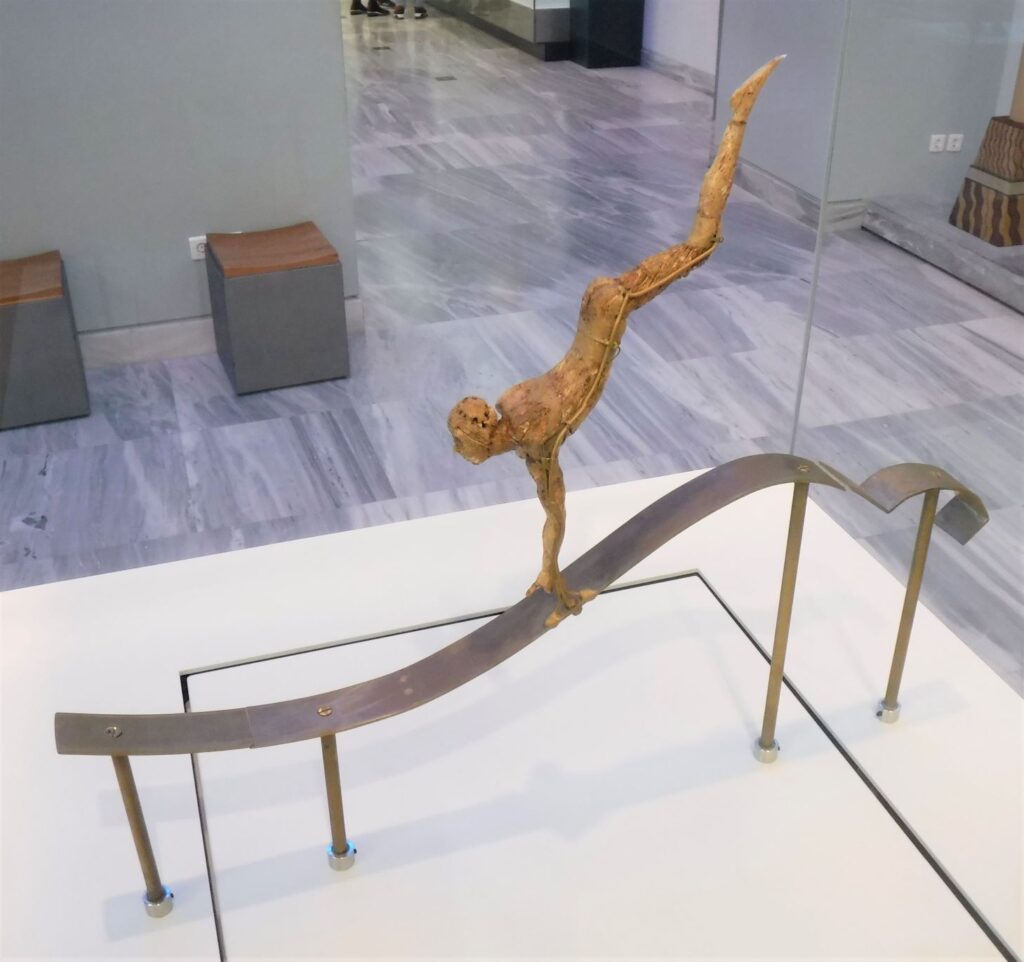
This carved ivory bull leaping figure was also found at the Palace of Knossos.
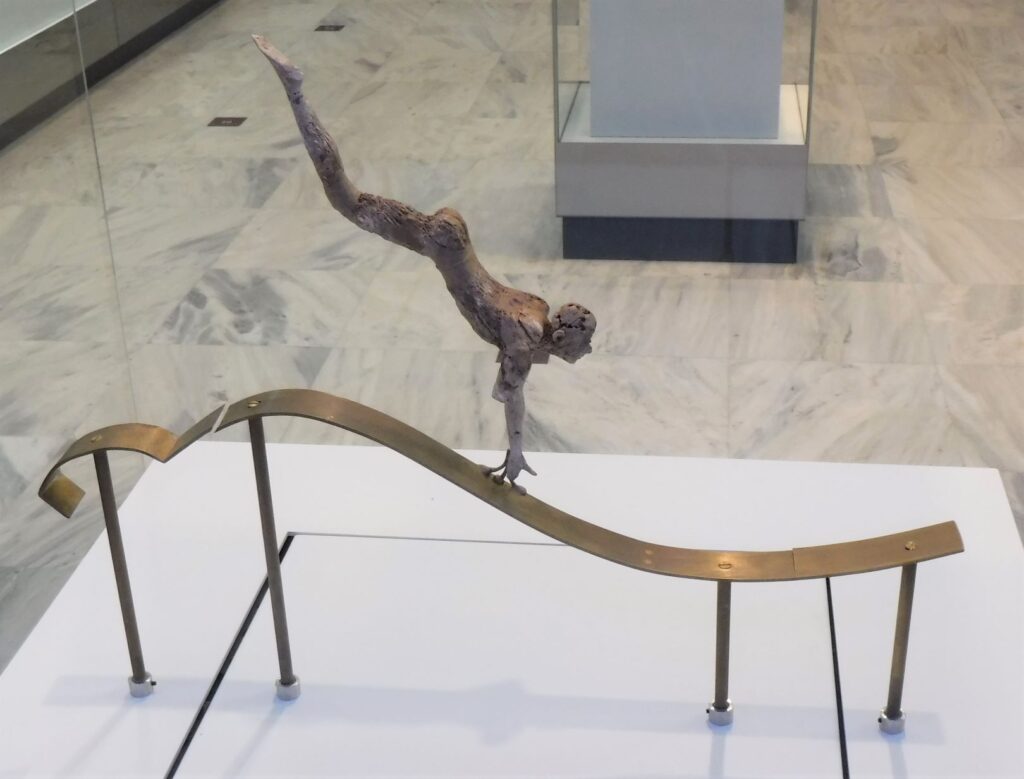
Presumably the figure originally had two arms and two legs.
The Palace of Knossos certainly contributed the lion’s share of bull leaping artefacts, with this painting on rock crystal also being scratched up at the site.
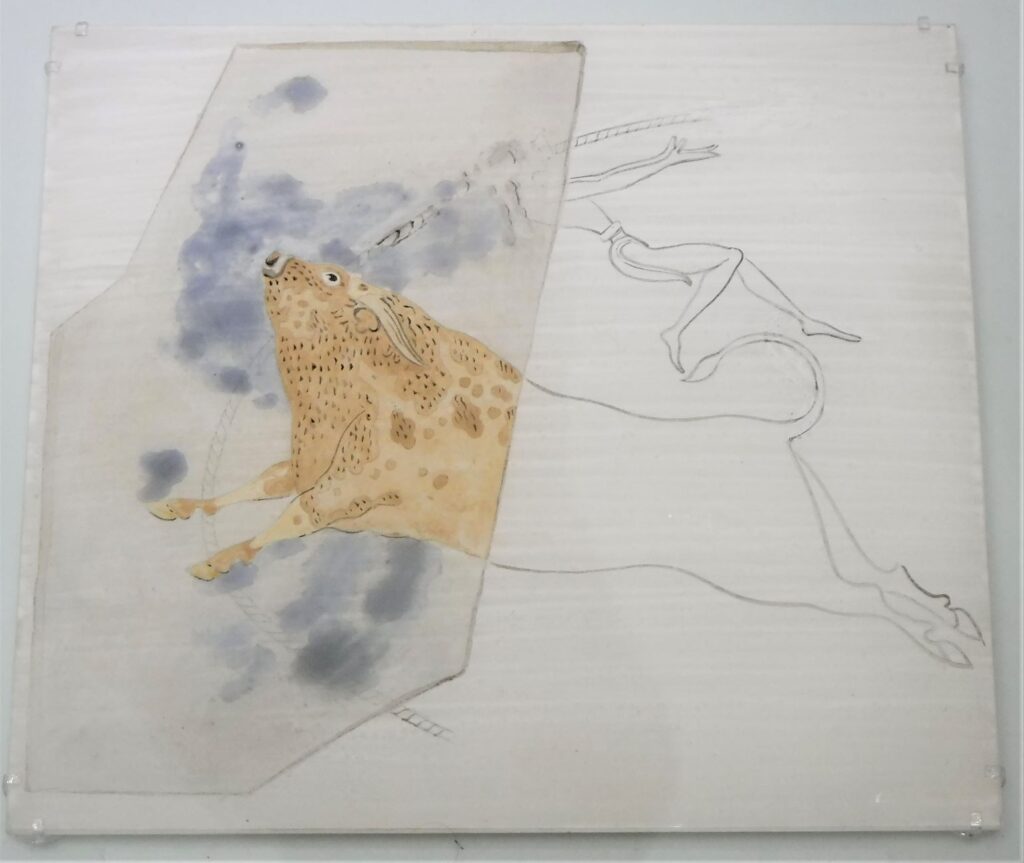
Whilst touring the sunny island, I visited the ancient Minoan Palace of Phaistos, near the village of Vori in south-central Crete. In the glory years of the Minoan civilisation, the Palace of Phaistos (built on the Hill of Phaistos) was surrounded by a sprawling city (known, mysteriously, as the City of Phaistos). Although low walls are all that is left of most of the buildings, the Central Court is still well preserved.

The Palace was a flash affair, and similar to Knossos, would have hosted religious, cultural and social events. And in a prestigious city like Phaistos, that means spectators at the Palace’s Central Court would have thrilled to the sport of bull leaping.
This artist’s impression shows what a bull leaping scene may have looked like at the Palace of Phaistos. Spectators can be seen in the windows of the Palace, well out of harm’s way.
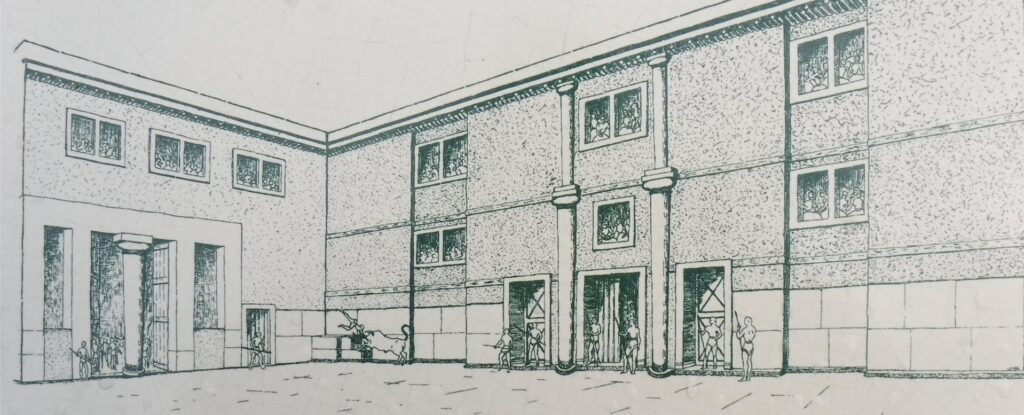
In the illustration, figures carrying spears can be seen. The weapons may have been used to try and control the bull, or protect the participants, or to euthanize a wounded leaper.
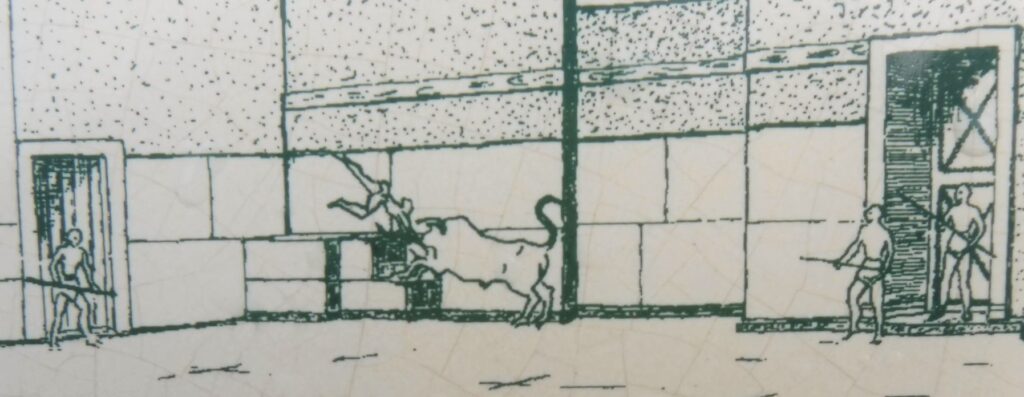
In addition to images of bull leaping on ancient artefacts, modern references to the sport can also be seen in the cities of Crete. This contemporary image can be found on the sides of street cafes and kiosks around Heraklion.

Amongst the information about bull leaping in the Heraklion Archaeological Museum are the following words: ‘The spirit of competition and excellence first cultivated by the Minoans was revived centuries later in the Olympic Games of ancient Greece, whose establishment was linked by mythological traditions to Crete.’ If the Minoan competitions were indeed the prototype Olympic Games, then I reckon the ancient Cretan athletic pursuits should be revived for the modern Games, rather than introducing a bunch of Johnny-come-lately sports.
So lets pay homage to both Minoan sports and athletes (both human and bovine), and push for bull leaping to feature at the 2024 Paris Olympics. We can drop one of the new sports, or finally get rid of the patently ludicrous ‘artistic swimming’, and put in bull leaping. Watching athletes somersault over massive bulls? I guarantee any sports fan would like to see that.
*naked
**very quickly
Check out the Heraklion Archaeological Museum here
If you liked this post, you may also enjoy Acropolis Museum, El Djem Colosseum
Leave a Reply